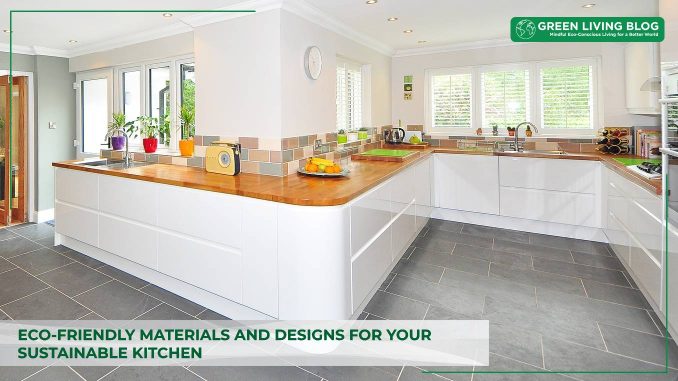
Embrace the beauty and functionality of eco-friendly kitchen designs with sustainable materials and innovative solutions.
This guide explores the best options for those aiming to merge style with environmental consciousness, ensuring every choice from splashbacks to shelving reflects a commitment to sustainability.
1. Upcycled Tiling Splashbacks

Recycled tiled splashbacks are an exemplary option for eco-conscious homeowners looking to infuse sustainability and style into their kitchens. Such tiles are crafted from repurposed ceramic or glass, significantly reducing landfill waste by giving new life to old materials.
Available in numerous tones and pattern combinations, they allow for personalised and distinctive design choices. Beyond aesthetics, these tiles are known for their durability and ease of maintenance, making them ideal for kitchen environments where practicality is as important as style. Choosing recycled tiles supports circular economy principles, emphasising a commitment to environmental stewardship.
In addition, sustainable tile adhesive and grout options are becoming increasingly popular for this sort of installation. These products are formulated to minimise environmental impact. Sustainable adhesives are often low in potentially harmful chemicals. Similarly, eco-friendly grouts can be non-toxic and are often made with natural or recycled components nowadays.
2. Stainless Steel Shelving
In a kitchen, stainless steel shelves offer both a sleek, contemporary aesthetic and practical benefits. It is renowned for its durability, resisting rust and corrosion, which makes it ideal for the humid, variable temperature conditions of a kitchen. Easy to clean and maintain, stainless steel shelves can handle spills and stains. Additionally, this material contributes to a minimalist design, helping smaller spaces appear larger by reflecting light. Importantly, stainless steel is also 100% recyclable, aligning with eco-friendly practices by minimising waste.
The tremendously long lifespan and recyclability of stainless steel make it a sustainable metal choice that reduces the environmental impact of frequent replacements. Alternatively, you could also opt for copper shelving units. Though less robust than steel, this material also benefits from natural antimicrobial properties, ideal for any food preparation environment.
3. Natural Solid Wood Worktops

Solid worktops made to measure from natural wood are highly valued for their beauty, durability, and eco-friendly attributes, making them a preferred choice for sustainable kitchen designs. Crafted from sustainably sourced timber, these worktops offer a warm, inviting aesthetic that complements any kitchen style, from traditional to contemporary. The unique grain patterns and rich colours of wood provide a natural artistry that cannot be replicated by synthetic materials.
Beyond their visual appeal, solid wood worktops are remarkably durable and can last for decades if maintained properly, which involves regular oiling and sanding to prevent damage and wear. This not only extends the life of the worktop but also reduces the need for replacement, thereby minimising waste. Moreover, wood is a biodegradable and renewable resource, enhancing its sustainability. According to one leading supplier of wooden worktops in the UK, by choosing natural solid wood, homeowners often report they feel they’ve contributed to the environment by supporting sustainable forest management practices that underscore their commitment to responsible living.
4. Sustainable Flooring Options
Choosing sustainable flooring options significantly enhances the eco-friendliness of a kitchen. Materials such as bamboo and reclaimed wood are popular for their low environmental impact. Bamboo is highly renewable, growing rapidly and absorbing carbon at an accelerated rate. Like upcycled splashbacks, it is also possible to obtain used tiling for a sustainable flooring option, these days.
On the other hand, reclaimed wood is also a good choice worthy of consideration. It not only reduces the need for new timber harvesting but also offers a unique aesthetic with historical character. Although these flooring options won’t suit every kitchen design style, each of them promotes a sustainable lifestyle by utilising resources that are either abundant or salvaged, reducing the ecological footprint of home renovations.
5. Low-VOC Paints and Finishes

Paints that are low in volatile organic compounds (VOCs) are critical for creating a healthier kitchen environment. These products release fewer airborne chemicals, improving indoor air quality and reducing exposure to potential toxins. Available in a wide range of colours and finishes, low-VOC products do not compromise on quality or durability.
Low-VOC finishes are particularly beneficial in kitchens, where maintaining clean, uncontaminated air is essential. Opting for low-VOC paints and finishes is a straightforward way to contribute to environmental sustainability while ensuring the safety and well-being of the household.
Summary
Transforming your kitchen with sustainable materials not only contributes to a healthier environment but will also typically add timeless charm to your home. By choosing eco-friendly options like recycled tiles, stainless steel or natural wood, you’re investing in both the planet’s future and a stylish, functional space that stands the test of time.
![]()
Author Profile
- Online Media & PR Strategist
- Blogger and Educator by Passion | Senior Online Media & PR Strategist at ClickDo Ltd. | Fascinated to Write Lifestyle Blogs in News & Education I have completed a journalism summer course at the London School of Journalism and manage various blogs.
Latest entries
 Green Expert GuidesMarch 28, 2025Lisbon Living: Where Sustainable Charm Meets Urban Energy
Green Expert GuidesMarch 28, 2025Lisbon Living: Where Sustainable Charm Meets Urban Energy EnvironmentJanuary 21, 2025Buying Eco-Friendly Homes: 6 Eco Questions to Ask Your Real Estate Agent
EnvironmentJanuary 21, 2025Buying Eco-Friendly Homes: 6 Eco Questions to Ask Your Real Estate Agent BusinessJanuary 16, 202510 Benefits of used Office Furniture when Refurbishing an Office
BusinessJanuary 16, 202510 Benefits of used Office Furniture when Refurbishing an Office Best practicesJanuary 6, 2025Eco-Friendly Event Planning: Mastering Sustainable Waste Management for Holiday Celebrations
Best practicesJanuary 6, 2025Eco-Friendly Event Planning: Mastering Sustainable Waste Management for Holiday Celebrations






Leave a Reply
You must be logged in to post a comment.